
About UsThe Numismatic Bibliomania Society is a non-profit organization devoted to the study and enjoyment of numismatic literature. For more information please see our web site at coinbooks.org SubscriptionsThose wishing to become new E-Sylum subscribers (or wishing to Unsubscribe) can go to the following web page link MembershipThere is a membership application available on the web site Membership Application To join, print the application and return it with your check to the address printed on the application. Membership is only $20 to addresses in the U.S., $25 for First Class mail, and $30 elsewhere. For those without web access, write to: David M. Sundman, Treasurer
AsylumFor Asylum mailing address changes and other membership questions, contact David at this email address: dsundman@LittletonCoin.com SubmissionsTo submit items for publication in The E-Sylum, just Reply to this message, or write to the Editor at this address: whomren@gmail.com BUY THE BOOK BEFORE THE COIN |
- WAYNE'S WORDS: THE E-SYLUM DECEMBER 7, 2014
- KOLBE AND FANNING 20% OFF LITERATURE SALE
- KOLBE & FANNING 2015 NEW YORK BOOK AUCTION
- NEW BOOK: GUIDE BOOK OF HARD TIMES TOKENS
- NEW BOOK: CASA DE MONEDA DE MADRID
- NEW BOOKS IN THE MONETA SERIES: #178-179
- BOOK REVIEW: NEVILLE CHAMBERLAIN - THE ART OF APPEASEMENT
- BOOK REVIEW: KENNEDY WORLD IN MEDALLIC ART
- BOOK REVIEW: PLEASURE & PROFIT
- SAIGON TIMES INTERVIEWS AUTHOR HOWARD DANIEL
- THE 1953 EMPEROR NORTON GOLD MEDAL
- NOTES FROM E-SYLUM READERS: DECEMBER 7, 2014
- WATSON'S 1962 NOBEL MEDAL BRINGS $4.75 MILLION
- BONHAMS TO OFFER EXPERIMENTAL ULTRA HIGH RELIEF $20
- ON MEDALS ISSUED AFTER THE ARTIST'S DATE OF DEATH
- LIBERTY DOLLAR CREATOR BERNARD VON NOTHAUS SENTENCED
- SOME ELECTROTYPES AND CONTEMPORARY COUNTERFEITS
- SELECTIONS FROM THE DIX NOONAN WEBB FEBRUARY 2015 SALE
- 1830 PHILIPPINES MANILA OVERSTRIKE 8 REALES
- CHRISTUS VITAE COLLECTION OF SHEKELS FROM THE LIFETIME OF JESUS
- MOSQUES DEPICTED ON PROPOSED ISLAMIC STATE COINS
- VENDING MACHINE INDUSTRY FIGHTS NEW £1 COIN
- A BRIEF HISTORY OF THE MONEYMUSEUM
- SELECTIONS FROM THE MONEY MUSEUM COLLECTION
- EURO BANKNOTES ARRIVE IN LITHUANIA UNDER HIGH SECURITY
- NEW ZEALAND'S NEW BANKNOTE DESIGNS
- FEATURED WEB SITE: MONEYMUSEUM
Click here to access the complete archive
To comment or submit articles, reply to whomren@gmail.com
WAYNE'S WORDS: THE E-SYLUM DECEMBER 7, 2014

New subscribers this week include: Alexander Krapf, Chris Freeland and Robin Tutterow. Welcome aboard! We now have 1,795 subscribers.
This week we open with two updates from Kolbe & Fanning, four new books and three reviews. Other topics include Emperor Norton's 1953 gold medal, Liberty Dollar creator Bernard von Nothaus, electrotypes and contemporary counterfeit coins, the Shekel of Tyre, the MoneyMuseum, and New Zealand's new banknote designs.
To learn more about the Antwerp edition of Goltzius, 1790s pamphlets by Augustin Dupré regarding his role in French coinage, Casa de Moneda de Madrid, Neville Chamberlain medals, the classicism of ancient coin designs, the Sans Serif lettered edge 1907 Saint-Gaudens Ultra High Relief $20, the 1910 George V gold Pattern Crown, and mosques depicted on proposed islamic state coins, read on. Have a great week, everyone!
Wayne Homren
Editor, The E-Sylum
KOLBE AND FANNING 20% OFF LITERATURE SALE
Kolbe & Fanning are holding a three-day sale Sunday through Tuesday, Dec. 5–7. During that time, all sales from our online inventory of over 1200 titles will be 20% off. Just add the code BOOKS when you are checking out to get the discount. In addition, all orders shipped to a U.S. address will be shipped at a $5 flat rate (foreign deliveries will continue to be charged for the actual cost). Go to www.numislit.com to browse our inventory or to search for specific titles.
KOLBE & FANNING 2015 NEW YORK BOOK AUCTION
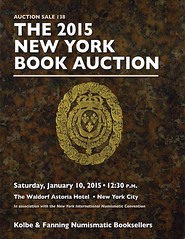 Kolbe
& Fanning Numismatic Booksellers are pleased to announce that they will be conducting a public auction of important numismatic books on Saturday,
January 10, 2015 at the Waldorf-Astoria Hotel in New York City. The auction will be held in conjunction with the New York International Numismatic
Convention (NYINC).
Kolbe
& Fanning Numismatic Booksellers are pleased to announce that they will be conducting a public auction of important numismatic books on Saturday,
January 10, 2015 at the Waldorf-Astoria Hotel in New York City. The auction will be held in conjunction with the New York International Numismatic
Convention (NYINC).
The sale features outstanding numismatic works covering ancient, medieval, modern foreign and United States coins and medals. The 2015 sale is especially strong in classic books on post-Renaissance European coins and medals and United States numismatic rarities. Among the many highlights are:
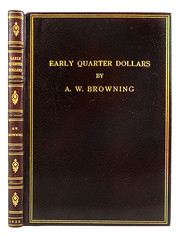 --Perhaps the finest existing deluxe copy of Browning’s 1925 work on early U.S. quarter dollars, one
of only 5 bound in full morocco (lot 230).
--Perhaps the finest existing deluxe copy of Browning’s 1925 work on early U.S. quarter dollars, one
of only 5 bound in full morocco (lot 230).
--An exceptional volume of 1790s pamphlets by Augustin Dupré regarding his role in French coinage, from the author’s own library (lot 112).
--The extremely rare and virtually unknown 1682 first issue in book form depicting the Sun King’s collection of ancient coins (lot 156).
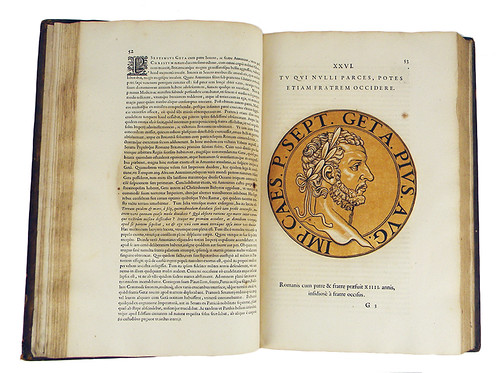
--The monumental 1708 five volume collected Antwerp edition of Goltzius, including the magnificent Icones volume (lot 33).
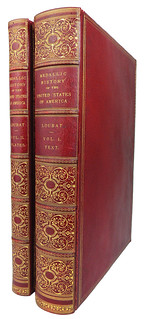 --A superb, richly gilt, deluxe leatherbound set of the virtually unknown 1881 edition of
Loubat’s Medallic History of the United States (lot 281).
--A superb, richly gilt, deluxe leatherbound set of the virtually unknown 1881 edition of
Loubat’s Medallic History of the United States (lot 281).
--An original set of Babelon’s Traité des monnaies grecques et romaines (lot 5), with de Morgan’s continuation of it as well (lot 6).
--A complete, first-edition set of the British Museum Catalogue of Greek Coins in sound, restored original bindings (lot 12).
--Van Loon’s classic work on Dutch medals, complete and handsomely bound, with the rare continuation (lot 155).
--Henry Hines’s copy of the deluxe leatherbound Newcomb on the cents of 1801-03, with correspondence and other materials laid in, ex Stack Family library (lot 297).
--A fine set of Stack’s catalogues, complete through the late 1990s (lot 311).
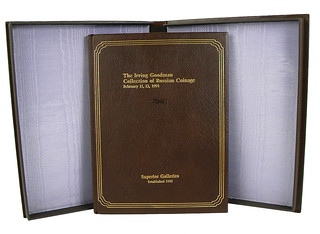 --The extremely rare leatherbound deluxe edition of the 1991 Irving Goodman sale of Russian coins (lot 199).
--The extremely rare leatherbound deluxe edition of the 1991 Irving Goodman sale of Russian coins (lot 199).
The sale includes many other notable works not mentioned above, including rare books on ancient coins, important publications on medals, and extremely rare photographically illustrated U.S. auction catalogues.
Printed catalogues are being mailed to established clients. A PDF of the catalogue has been posted to the Kolbe & Fanning website. Prospective bidders may also access the live online catalogue and register to bid through the main website at www.numislit.com.
The sale will begin at 12:30 p.m. in the Norse Suite on the 18th Floor of the Waldorf-Astoria Hotel on January 10. Lot viewing will be held in the Library Suite on the same floor on Thursday, January 8 from 9:00 a.m. to 5:00 p.m., on Friday, January 9 from 9:00 a.m. to 6:00 p.m., and on the day of the sale from 9:00 a.m. till noon.
Absentee bids will be accepted via post, phone, email and fax (deadlines will be announced later). Live online bidding will be available through Kolbe & Fanning’s online auction portal at auction.numislit.com (managed through iCollector). Bidders planning to participate in the sale online are strongly encouraged to register in advance.
Kolbe & Fanning Numismatic Booksellers LLC is a licensed auction firm in the State of Ohio and is conducting the sale in conjunction with Harmer Johnson, auctioneer. For more information, please see the Kolbe & Fanning website at www.numislit.com or email David Fanning at df@numislit.com. We look forward to your participation.
David F. Fanning, Ph.D.
Kolbe & Fanning Numismatic Booksellers LLC
141 W. Johnstown Rd.
Gahanna, OH 43230
(614) 414-0855
Cell (614) 256-8915
Fax (614) 414-0860
df@numislit.com
www.numislit.com
Members ANA, ANS, IAPN
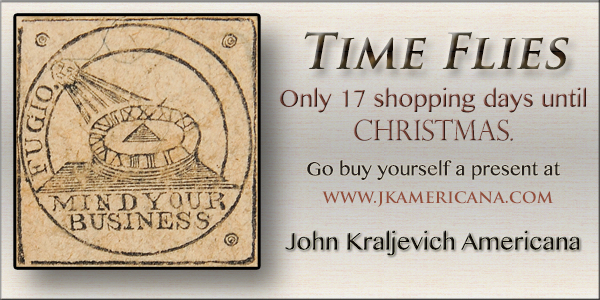
NEW BOOK: GUIDE BOOK OF HARD TIMES TOKENS
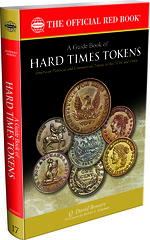 Whitman Publishing announces the release of A Guide Book of Hard Times Tokens, by Q. David Bowers. The 320-page softcover book (number 17 in
the popular Bowers Series) will debut at the Whitman Coin and Collectibles Expo in Baltimore, March 26, 2015. In the meantime copies can be
pre-ordered from booksellers and hobby shops nationwide, and online (including at www.Whitman.com), for $29.95. The book can also be borrowed for
free as a benefit of membership in the American Numismatic Association, through the Dwight N. Manley Numismatic Library.
Whitman Publishing announces the release of A Guide Book of Hard Times Tokens, by Q. David Bowers. The 320-page softcover book (number 17 in
the popular Bowers Series) will debut at the Whitman Coin and Collectibles Expo in Baltimore, March 26, 2015. In the meantime copies can be
pre-ordered from booksellers and hobby shops nationwide, and online (including at www.Whitman.com), for $29.95. The book can also be borrowed for
free as a benefit of membership in the American Numismatic Association, through the Dwight N. Manley Numismatic Library.
Privately minted “Hard Times” tokens are tangible reminders of a turbulent period in America. Their political and commercial motifs are diverse, reflecting the economic and social scene of the pre–Civil War era of Andrew Jackson (the 1830s and 1840s).
Award-winning author Q. David Bowers includes recent research findings as well as information he has gathered since the 1950s; hundreds of high-resolution images; and current market pricing in multiple grades. He covers the historical context of the Hard Times of 1832 to 1844, during which President Andrew Jackson fought the controversial Second Bank of the United States. Many situations and incidents are presented in a narrative style, including the story of Peggy (O’Neal) Eaton, the controversial belle of Washington, D.C., whose flirtatious actions rearranged Jackson’s Cabinet and was responsible for Martin Van Buren being nominated for president.
It was an era of financial collapse and nationwide depression. Private minters and businessmen created cent-sized copper tokens to fill the gap when official U.S. coins became scarce. Many of these have colorful and satirical political themes, while others advertise local businesses, making them a treasure trove for historians. Bowers catalogs these tokens with detailed information for sellers, collectors, and researchers.
“Numismatists find Hard Times tokens fascinating to study,” says Bowers. “There are hundreds of issues to collect, and most of them are very affordable. For the specialist who enjoys a challenge, there are also some major rarities in the series.”
Numismatic researcher and Hard Times expert Robert A. Schuman calls the book “groundbreaking,” “beyond the scope and depth of anything previously published,” and “a clear, complete, verified, carefully focused, and well-photographed listing of these important pieces.”
The Guide Book of Hard Times Tokens also includes biographies of die engravers, histories of issuing firms, narratives about the political personalities involved, a catalog of fantasy pieces, a history of the market and collector interest going back to the mid-1800s, extensive notes, a bibliography, charts cross-referenced to the older Low and Rulau cataloging systems, and an index. Much of its information has never been published in book form before.
Whitman publisher Dennis Tucker notes that Hard Times tokens have been summarized in the Guide Book of United States Coins (the hobby’s best-selling annual price guide, known as the Red Book) since the first edition in 1946. “This is the first time collectors have had an expanded, full-color catalog to these remarkable pieces of American history,” Tucker says.
A Guide Book of Hard Times Tokens
By Q. David Bowers; foreword by Robert A. Schuman
ISBN 079484295X • 6 x 9 inches, softcover, 320 pages, full color • Retail $29.95 U.S.
For more information, or to order, see:
https://www.whitman.com/store/Inventory/Detail/A-Guide-Book-of-Hard-Times-Tokens+079484295X
NEW BOOK: CASA DE MONEDA DE MADRID
 Glenn
Stephen Murray Fantom, Casa de Moneda de Madrid: cantidades acuñadas y ensayadores. En conmemoración del 400 aniversario de su fundación en
1614. Friends of the Segovia Mint, 2014, Segovia. Paperback, 15 x 21 cm, 186 pages, in color. Price: 12,00 euros plus postage fee.
Glenn
Stephen Murray Fantom, Casa de Moneda de Madrid: cantidades acuñadas y ensayadores. En conmemoración del 400 aniversario de su fundación en
1614. Friends of the Segovia Mint, 2014, Segovia. Paperback, 15 x 21 cm, 186 pages, in color. Price: 12,00 euros plus postage fee.
The Friends of the Segovia Mint Association has just published another new book, written by Dr. Glenn Murray: “The Madrid Mint: Mintage Statistics and Assayers. In Commemoration of the 400th Anniversary of the Mint’s Founding in 1614”. The 188 page book (15 x 21 cm), in color, has been published by the Association, in its 21st year of existence, without external economic assistance, and has been economically priced to make it easily available for everyone. Honoring the Association’s tradition, this book is mailed free of charge to each of the nearly 200 members.
The book is designed to establish a basis for the rarity of coins struck in Madrid based on historic documents, as opposed to pricing opinions currently used in catalogs prepared by coin dealers. These statistics, the only real gauge for rarity, have never before been published, while at the same time are the most sought after information by coin collectors as well as dealers. These unpublished statistics are compared metal by metal and year by year in 51 different charts encompassing all coins struck from 1615 to 1868. In this manner, the author aims to establish a panoramic view of all Madrid coins known to date and of those which may or may not appear in the future.
On the other hand, the book has been designed to be as didactic, easy to understand and enjoyable as possible, even for those just starting in numismatics. For this reason, basic concepts related to coin production are explained, such as the availability of gold and silver to strike into coin, legislation regarding the issue or prohibition of certain series, as well as other factors which came into play affecting yearly production. Also considered are obstacles which these coins have had to overcome in order to survive until our times. In these regards, the frequent campaigns for the removal of certain series from circulation and their melting are listed and discussed. These concepts are fundamental for us to take into account when attempting to understand the possibility of the appearance of a heretofore unknown date in any series.
To complement the mintage statistics, the book offers complete biographies for each of the assayers whose marks appear on coins struck in Madrid including their signatures and dates of promotions or death. An index of assayer marks helps make identification of these symbols on the coins quick and easy.
Regarding the buildings which the Madrid Mint has occupied over the centuries, images and maps help readers locate these sites, since these historic buildings do not exist today.
Towards the rear of the book are 20 charts for the quick identification of weights and fineness of each issue, including the number of pieces able to be struck from one kilo of metal. These never before published charts, of the author’s own confection, cannot be found in other numismatic literature and contain the mathematical formulas used to calculate the exact number of pieces struck each year starting in 1730 and the total weight in kilos struck from each metal, each year from 1615 to 1868.
This is the first time that this type of book has been published in Spain, based on archival documentation rather than pricing opinions by coin dealers. The low purchase price of the book can be quickly recovered by buying or selling coins struck in Madrid with the advantage of knowing these unpublished mintage statistics.
For more information or to order the book go to the website of the Friends of the Segovia Mint …
To read the complete article, see:
New book on the Madrid Mint (www.coinsweekly.com/en/News/4?&id=3164)
To order from Friends of the Segovia Mint, see:
www.segoviamint.org
NEW BOOKS IN THE MONETA SERIES: #178-179
MONETA 178: Finds and hoards in Belgium
XX. Celtic and Roman antiquity, Supplement 2
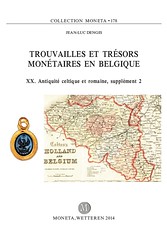 In 2012, we
published a first supplement relating to monetary finds and treasures of antiquity discovered on the territory. Since then many isolated currencies
and a score of important new treasures were unearthed in the country. In addition, a new visit, after plowing, sites already explored previously
allowed to complete the inventory and description of several monetary deposits already published.
In 2012, we
published a first supplement relating to monetary finds and treasures of antiquity discovered on the territory. Since then many isolated currencies
and a score of important new treasures were unearthed in the country. In addition, a new visit, after plowing, sites already explored previously
allowed to complete the inventory and description of several monetary deposits already published.
Thus several hundred isolated currencies were again exposed. Agricultural work have collected new copies for us to complete information on ancient deposits. This is for Gallic coins, Thuin II and III, and for Roman coins of Anthisnes I, Forest Trooz I Wandre I, II and Bellefontaine Heinsch II. On the other hand, the inventory of Roman coin hoards can be enriched with deposits Blaton I Colfontaine I, Gouy-lez-Pedestrian I, II Naast, Péruwelz I Rumes I Thiméon I Freylange I, I Martelange , Rendeux I and II, and finally I Denee Ave-et-Auffe I. This update was all the more necessary that the already published works have met with great success and encouragement from several academic authorities.
This book, as in the past, is structured so that the scientific staff or, more simply, the curious and the lover of local history can easily find there the object of their research since it has easy access both inventories of findings classified in alphabetical order, in a borough by ranking. A chronological table of landfills, updated, naturally complete this study. A bibliography is included at the end of this new volume.
This tool should again not only interest the curious and lovers of local history to discover their roots, but also, of course, numismatists, collectors, archaeologists, historians and economists.
MONETA 178, 174 pages 70 euros Contents ISBN 978-94-91384-46-2
For more information, or to order, see:
www.moneta.be/volumes/moneta_178.htm
MONETA 179: The Silver Coinage of Istros
 This volume
represents the most detailed study to date on the very large silver coinage of Istros.
This volume
represents the most detailed study to date on the very large silver coinage of Istros.
Although the proposed datings and order of certain issues will inevitably undergo changes in future, the fact that silver coins of the classic type were being minted on a regular basis at Istros until the second half of the 3rd century BC can no longer be in any doubt. This is the most important conclusion of this work, and as such has profound implications from a numismatic, archaeological and historical point of view, given that a large number of coins, hoards and archaeological layers, etc., had until now been dated erroneously – based on the silver coins of Istros – to the 4th century BC.
The other publications of Mihai Dima are related to some of the most important Ancient coin hoards discovered in Romania as well as to the coin circulation in Dobrudja during the Roman period.
MONETA 179, 194 pages 75 euros ISBN 978-94-91384-47-9
For more information, or to order, see:
www.moneta.be/volumes/moneta_179.htm
MONETA publishes books on numismatics, monetary history, economy, from antiquity to present, all continents, all languages, see www.moneta.be.
THE BOOK BAZARRE
BOOK REVIEW: NEVILLE CHAMBERLAIN - THE ART OF APPEASEMENT
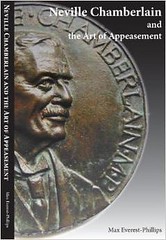 Max Everest-Phillips, Neville Chamberlain and the Art of Appeasement (2013), pp. 234. With
illustrations. i2f Publishing. ISBN 978-1-909345-10-2.
Max Everest-Phillips, Neville Chamberlain and the Art of Appeasement (2013), pp. 234. With
illustrations. i2f Publishing. ISBN 978-1-909345-10-2.
Dismounting the steps of his return flight from Munich on 30 September 1938, amidst the assembled crowd of press and newsreel reporters at Heston Aerodrome, Neville Chamberlain, British Prime Minister, waving a piece of paper jointly signed by Hitler and himself that morning, announced that he had obtained `Peace in Our Time'.
This brief but widely-known episode constitutes the culmination of the Munich Conference, the two-day meeting on 28-29 September between Hitler, Mussolini, Edouard Daladier (President of France) and Chamberlain - and the backdrop to this fascinating book - during which the terms of peace were agreed, the fate of democratic Czechoslovakia having been left to the mercy of the Third Reich.
The collective sigh of relief at Chamberlain's apparent success gave rise to the issue of commemorative material, much of it in the form of medals. Public reaction to the peace was understandable, when seen against the shadow of the First World War; and with its scale of human tragedy still hanging heavy, another such war was to be avoided at almost any cost. Affecting not only Britain but also much of Europe, it is no surprise that medals commemorating Chamberlain and the Munich Agreement also should have been produced by French and German medallists for their respective markets.
As well as illustrating the medals, the book includes a great deal of relative material in the form of cartoons, and with a cast of characters that include Hitler, Mussolini and Chamberlain, what better source material could a caricaturist possibly wish for. Also included are photographs of the main protagonists, their manner of interaction providing an additional angle of interest, as we see observe Chamberlain blithely walking into disaster.
We learn how the British Prime Minister was to stage-manage the media for purposes of public consumption, allowing himself to be photographed with Mrs Chamberlain taking a stroll around St. James, as might any ordinary couple, or fumbling with the keys of Number 10 Downing Street, as they are seen at its back entrance unlocking the door.
The book captures the heightened emotions of the period, extracting a speech delivered to the House of Commons by Clement Atlee, four days after Chamberlain's return from Munich and the `sense of relief', following `days of anxiety' , and what some considered neither a victory for reason and humility but one for `brute force'.
Amongst the more amusing images is that of a troupe of six leggy female cabaret dancers, each moustachioed, wearing a top hat and carrying a furled umbrella on their right arm - Chamberlain being very much the man of the moment, day and night.
The book provides an extensive catalogue of the commemorative medals issued in 1938, and beyond, and includes many of those made under Nazi Germany, detailing not only the medallist but also, where known, the publisher and issue price.
In dealing with those made by the prominent German satirist Karl Goetz, the author raises the question of this medallist's sympathies, so clearly defined and projected are his medallic designs of this time.
The book illustrates just how powerful the propaganda value of the medal happens to be, and the episode that it covers is as good an exemplar of this as it is possible to find.
It was the chance discovery in 1994 of Muriel Hiley's uniface portrait medal of Neville Chamberlain, spotted in the window of a south-west London junk shop, which set Max Everest-Phillips on his quest.
Scattered far and wide as this material has become, the author has dug far and wide to produce a work of considerable interest that both entertains and informs, inviting us to look afresh at this extraordinary period of recent history.
Christopher Eimer
25 October 2013
To read the complete review, see:
Neville Chamberlain - The Art of Appeasement:: 1
(www.amazon.co.uk/Neville-Chamberlain-The-Art-Appeasement/dp/1909345105)
To read the earlier E-Sylum article, see:
NOTES FROM PAUL BOSCO ON NORTON, CHAMBERLAIN AND PLATE MONEY : Neville Chamberlain
Medals (www.coinbooks.org/esylum_v17n49a11.html)
BOOK REVIEW: KENNEDY WORLD IN MEDALLIC ART
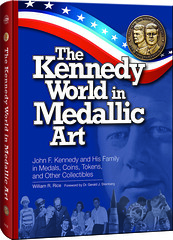 William Rice’s 304-page hardcover book, The Kennedy World in Medallic Art: John F. Kennedy and His
Family in Medals, Coins, Tokens, and Other Collectibles brings to life the many different ways in which the nation's 35th president has been
remembered. John F. Kennedy was one of the United States' most popular presidents and one of the most commemorated. This book goes far beyond the
Kennedy half-dollar that many people saved in 1964.
William Rice’s 304-page hardcover book, The Kennedy World in Medallic Art: John F. Kennedy and His
Family in Medals, Coins, Tokens, and Other Collectibles brings to life the many different ways in which the nation's 35th president has been
remembered. John F. Kennedy was one of the United States' most popular presidents and one of the most commemorated. This book goes far beyond the
Kennedy half-dollar that many people saved in 1964.
“William Rice builds on the foundation that Edward Rochette and Aubrey Mayhew started with their numismatic studies in the 1960s,” says Whitman publisher Dennis Tucker. “Today’s collector benefits from full-color images and 50 years of ongoing research. John F. Kennedy is one of the most popular presidents in American history, and many of these coins, medals, and tokens can be found at local coin shows, flea markets, antique malls, and online.”
History of JFK and His Family
Rice takes an in-depth look at the life of President Kennedy and his family. From the very first chapter of the book he takes a look back on the
history of the president's family and how they rose to power. There are chapters on his military service, congressional career, and his
presidential campaign. Special attention is given to the history of his presidency beginning with his inauguration and concluding with his
assassination.
Kennedy historian Rice, dives deep into the life and times of the president. You'll also learn about and see artifacts from JFK's boyhood, his military service, early political career, his wife Jacqueline, his children, life in the White House and the mourning that the country went through following his assassination. However, this book is not a one-sided presentation of the history of JFK. There is a chapter that covers satirical and critical pieces from the anti-Kennedy movement.
Photos and Illustrations Galore
This 304 page book is packed full of historical photos, newspaper clippings, medals, rings and other historical objects. Sidebars give you detailed
information on the topic being covered. All of this is illustrated by more than 1,500 images of coins, medals, tokens, stamps, paper currency and
other memorabilia. Some of these are quite common and others are rarely seen. Military challenge coins are covered in depth with more than 180
full-color images.
In addition to the full-color historical images and narrative, the book contains multiple appendices, a bibliography, and a full index. If you collect Kennedy memorabilia, you will benefit from the catalog numbering system and commentary on today's buy and sell market. The book concludes with a 52 page appendix that catalogs more than 2,670 individual items by date, size, composition, and description.
Product Details
Hardcover: 304 pages
Publisher: Whitman Publishing, LLC (September 30, 2014)
Language: English
ISBN-10: 0794842364
ISBN-13: 978-0794842369
Product Dimensions: 10.9 x 8.6 x 0.7 inches
To read the complete article, see:
Book Review: The Kennedy
World in Medallic Art (coins.about.com/od/Coin-Books-And-Publications/fl/Book-Review-The-Kennedy-World-in-Medallic-Art.htm?nl=1)
To read the earlier E-Sylum articles, see:
NEW BOOK: THE KENNEDY WORLD IN MEDALLIC ART (www.coinbooks.org/esylum_v17n37a07.html)
BOOK REVIEW: KENNEDY WORLD IN MEDALLIC ART (www.coinbooks.org/esylum_v17n45a04.html)
BOOK REVIEW: PLEASURE & PROFIT
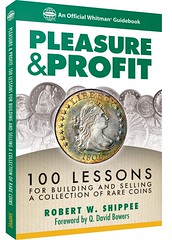 BOOK
REVIEW: Pleasure & Profit: 100 Lessons for Building and Selling a Collection of Rare Coins by Robert W. Shippee (Whitman Publishing, 2014)
By Steve Bishop
BOOK
REVIEW: Pleasure & Profit: 100 Lessons for Building and Selling a Collection of Rare Coins by Robert W. Shippee (Whitman Publishing, 2014)
By Steve Bishop
When it comes to guides to investing in rare coins, the gold standard for me is The Expert’s Guide to Collecting and Investing in Rare Coins by Q. David Bowers (also from Whitman). Whitman’s newest offering in this area is a worthy supplement to that essential work, as well as a nice companion volume to A Guide to United States Type Coins, also by Bowers (prolific fellow, this Bowers; he also provided the Forward for this work).
Unlike most works on investing, this book is not laid out as a series of instructions relating to rare coin investing in general, but as a series of examples pertaining to a collection put together and then sold by Mr. Shippee, specifically a fine collection of U.S. type coins from half cents to double eagles. The collection was auctioned by Stack’s in 2007 as the Waccabuc Collection.
The book starts out with an account of how the author got started in coin collecting and a chapter devoted to outlining the various aspects of what makes coins rare and valuable, as well as an outline of various ways to buy coins (an appendix outlines how to sell). A chapter is devoted to each denomination in the collection, with Stack’s catalog description for each coin accompanied by Shippee’s comments on the particular type, the coin he selected for each type, the amount he paid for the coin, the amount it realized, and a lesson he learned from that particular coin.
It is Shippee’s focus on lessons applicable to specific coins bought and sold that sets this book apart. While most books on coin investing provide general advice applicable to rare coins in general, this one stands out by tailoring the lessons to specific coins, although many of the lessons may be generally applied. Many of the lessons echo what is covered in great detail by Bowers in the Expert’s Guide, such as selecting a coin by condition, surface quality, and strike quality, but the book is particularly useful by focusing on specific series and coins within those series.
Not all of the lessons that Shippee learned were pleasant; in addition to successes, there were failures. Not all of the coins that he sold realized a profit; in fact, of the 138 coins in the Waccabuc Collection, 52 were sold at a loss. It is another strength of this book that the author doesn’t gloss over these losses and endeavors to learn something from them. Often failure teaches you more than success. In addition, some of the lessons are counterintuitive; my favorite being Shippe’s declaration that AU-58 is his favorite grade. This is counter to most guides’ advice to buy the highest grade coin you can afford. In many instances, buying a coin that is genuinely rare but in lesser condition works out better that buying a common coin in high grade.
Although I really liked this book, there was one thing that annoyed me. There are some footnotes (configured as end notes) in the text. A scholarly work that includes a lot of citations and other information that is of interest perhaps only to other scholars is justified by placing the notes at the end, but in this case, the reader would have been much better served by placing the notes at the bottom of the page where they could be readily taken in, since they included information that illuminated the text. Having to look in the back of the book for this additional information was a chore.
All in all, this book is a fine addition to any collector/investor’s library. Although tailored specifically to a U.S. type coin collection, the lessons are of general applicability to all rare coins. And for the golfers out there, Shippee, an avid golfer, includes humorous stories about golf that he links to rare coins. While they don’t really add anything of substance, they do add a bit of comic relief to a serious subject.
To read the earlier E-Sylum articles, see:
NEW BOOK: PLEASURE AND PROFIT (www.coinbooks.org/esylum_v17n40a04.html)
BOOK REVIEW: PLEASURE & PROFIT (www.coinbooks.org/esylum_v17n49a06.html)
SAIGON TIMES INTERVIEWS AUTHOR HOWARD DANIEL
Howard A. Daniel III writes:
I was recently interviewed and photographed by a reporter, Miss Hieu Thao, from the Saigon Times newspaper, and English language newspaper. Her English is not perfect and she did not correctly "hear" me, but she did a pretty good job. As a result of the article, I am now working on an article for another Vietnamese newspaper, and it will be centered on the coupons used on the Ho Chi Minh Trail for their Tet 2015 issue.
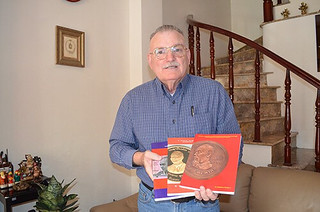 There are many people who are interested in money not only
for its exchange value but also for the stories behind the banknote. Each banknote carries with it a historical context that hardly anybody knows if
they do not devote their time to it. Besides the joy of possessing valuable and rare coins and banknotes, the knowledge of historical and social
backgrounds of currencies attracts people to collect them.
There are many people who are interested in money not only
for its exchange value but also for the stories behind the banknote. Each banknote carries with it a historical context that hardly anybody knows if
they do not devote their time to it. Besides the joy of possessing valuable and rare coins and banknotes, the knowledge of historical and social
backgrounds of currencies attracts people to collect them.
The 74-year-old American Howard A. Daniel III finds a great joy when studying currencies, and all the more so when it comes to Vietnamese banknotes and coins. The elderly man now is a widely recognized scholar in the field of numismatics, and has been compiling a great deal of materials on the local money after spending decades in this sector.
Daniel entered the sector as a collector, then a researcher and writer specializing in South East Asia’s currencies. His numismatics studies started in 1964 while he was in the army in Japan, working with big mainframe computers. He has published numismatics catalogs on French Colonial, Vietnam, Cambodia and Laos. At present, he is making the second edition of his Democracy Republic of Vietnam Coins and Currency catalog.
Daniel used to serve as a numismatics ambassador for years, giving lectures about Southeast Asian numismatics in the U.S., Europe, Canada and Asian countries. In 2000, after a conference in Jakarta, he thought of compiling numismatics catalogs for Vietnam because such a job had not been assumed by any in the country.
Numismatics associations in Indonesia, Singapore, Malaysia, Brunei and Myanmar have already taken over the compilation job in their countries. However, Vietnam, Laos and Cambodia still have not established numismatics associations, says Daniel. He hopes such associations will be established in these countries to encourage people to research and write their own catalogs.
Being an enthusiast in money studying, Daniel has still faced challenges, especially, the language barrier and lack of sources.
“I had to find a little piece of information in many locations in the world,” he talks to the Daily. He has spent many days searching through libraries around the world, including eighteen months of weekends in the Library of Congress in Washington D.C, looking from A to Z for information about Vietnamese and other currencies. Many other times, he has also visited private libraries and collections looking for new information, coins and banknotes. Whenever he finds a way out of a deadlock, both himself and his readers are rewarded with interesting and useful information.
Many Vietnamese numismatists, historians and researchers have been using Daniel’s catalogs about coins and currencies when he first published them in the U.S. Thousands of copies have been sold out after being published in Vietnamese.
Ho Hai, a member of the forum viet-numis.com, comments, “In my opinion, catalogs of Howard Daniel have plentiful references and accurate arrangements. It is helpful because the catalogs show meticulous works reflecting the currency development process of Vietnam.” Each catalog includes categorized lists of coins, notes, bullion bars and rounds, settlement checks and properties from private collections.
Having spent 50 years on Vietnamese numismatics research, Daniel still considers himself a student, not an expert. According to him, “an expert has nothing more to learn, and I know I have much more to learn. Even on November 11, I find something new in almost every collection, inventory and library I look at that I did not know before. This proves I am still a student, and I look forward to find something new every day.”
To read the complete article, see:
Studying values behind money
(http://english.thesaigontimes.vn/37789/Studying-values-behind-money.html)

THE 1953 EMPEROR NORTON GOLD MEDAL
Regarding the 1953 Emperor Norton gold medal sought by Neil Shafer, John Kraljevich writes:
Here's what one looks like! Struck in 14K gold by Shreve and Co. of San Francisco. And yes, despite being extremely rare, I did just happen to have one laying on my desk.
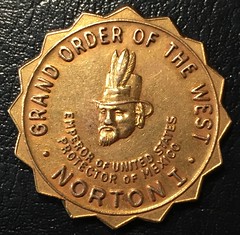
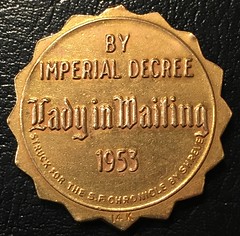

To read the earlier E-Sylum article, see:
QUERY: 1953 EMPEROR NORTON GOLD CROWN NOTES
(www.coinbooks.org/esylum_v17n48a23.html)
NOTES FROM E-SYLUM READERS: DECEMBER 7, 2014
Philadelphia Mint Director Portraits
Bob Julian writes:
At one time an upper hallway at the Philadelphia Mint contained a fair number of paintings of mint directors and superintendents. In 1970 I had several of these photographed, the negatives of which I still have. I have since heard that some of the paintings were removed for display in Washington, perhaps at Mint headquarters. I applied in 2011 to have photographs taken of artifacts still at the Philadelphia Mint, including some of the paintings that had been missed in 1970, but the request was ignored and I have no clear idea of the present situation.
To read the earlier E-Sylum article, see:
U.S. MINT DIRECTOR GEORGE N. ECKERT (www.coinbooks.org/esylum_v17n49a09.html)
The Classicism of Ancient Coin Designs
Regarding my comments on the Latvian Four Seasons Five Euro Coin, Dave Bowers writes:
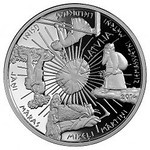 I agree with you about the “Ugh” coin. Actually, very few modern coins have much artistry at
all—but who am I to say? I like ornateness and classicism. Euainetos and Kimon must be proud that their ancient designs trump most of what is now
produced.
I agree with you about the “Ugh” coin. Actually, very few modern coins have much artistry at
all—but who am I to say? I like ornateness and classicism. Euainetos and Kimon must be proud that their ancient designs trump most of what is now
produced.
To read the earlier E-Sylum article, see:
SOME RECENT COINS DESIGNS: NOVEMBER 30, 2014 : Latvia Four Seasons Five Euro Coin
(www.coinbooks.org/esylum_v17n49a27.html)
A Video About the Explosion of World Coins
Jeff Starck of Coin World writes:
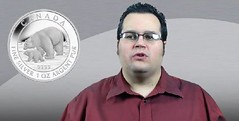 I can’t help but
read your comments following the piece about Brazil's Olympic coins (E-Sylum, Nov. 23) and think this dovetails with a topic I just
explored in the Monday Morning Brief this week. The subject is: are modern world coins like sports cards?
I can’t help but
read your comments following the piece about Brazil's Olympic coins (E-Sylum, Nov. 23) and think this dovetails with a topic I just
explored in the Monday Morning Brief this week. The subject is: are modern world coins like sports cards?
With 66 coins released in 24 hours by two mints alone, the market is clearly huge. Keeping track of them is a tough task, much less following them and deciding about their future potential as investments.
To watch the video, see:
Are modern world coins like sports cards?: Monday Morning
Brief, Dec. 1 (www.coinworld.com/videos/2014/12/monday-morning-brief-dec-1-2014.html)
To read the earlier E-Sylum article, see:
BRAZILIAN CENTRAL BANK'S BIG COIN LAUNCH
(www.coinbooks.org/esylum_v17n48a19.html)
George F. Heath on Pleasing All Readers
As a numismatic editor, Dave Bowers thought I might enjoy this item from editor George F. Heath of The Numismatist, December 1892 (I did!):
Dave Bowers writes:
“It would be impossible to please all of our readers. We regret that we cannot. Exceptions there have ever been since the morning stars sang together. There is a record of a snake being in Eden, and later of fallen angels. Some stars do not shine, some waters are bitter, some birds do not sing, and some roses give no perfume. Exceptions are everywhere. There are some persons who would grumble going to glory in a palace car; some will sit on the edge of a cloud, resplendent in all the magnificent effulgence reflected from the great white throne, and blame St. Peter for passing them into a place, that in their opinion, is not what it has been cracked up to be. If any of our readers have got into the wrong pew and don’t enjoy our sermonettes, they can leave the hymn and book in the pew, and pass off quietly. The ushers at the door will refund the money.”
The Henry P. Kendall Foundation Collection Hardbound Catalogs
U.S. colonial coin collectors may be interested in the hardbound catalog of the Kendall collection, which will be offered at public auction in
Baltimore, Maryland, as part of Stack’s Bowers Galleries Official Auction of the Whitman Coin & Collectibles Expo in March 2015. Brian Kendella
forwarded the following information at my request. Thanks!
For many decades, a private collector quietly assembled one of the finest collections of American colonial coins ever formed. Capably facilitated by legendary dealer Lester Merkin and assisted by the Stack family, the collection grew to include over 120 pieces of Massachusetts silver, outpacing the Boyd-Ford Collection to become the most complete grouping ever offered. The collection is now to be sold on behalf of and under the name the Henry P. Kendall Foundation, an American philanthropic enterprise that has been focused on environmental issues for more than 50 years.
To order, see:
www.stacksbowers.com
WATSON'S 1962 NOBEL MEDAL BRINGS $4.75 MILLION
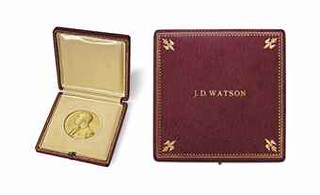 The Nobel Prize medal of celebrated American geneticist James Watson sold for $4.75 million in just
minutes at auction on Thursday in New York.
The Nobel Prize medal of celebrated American geneticist James Watson sold for $4.75 million in just
minutes at auction on Thursday in New York.
The sale, the first of a Nobel Prize by a living laureate, was considerably more than the $2.5-$3.5 million estimate, the auction house Christie's said.
Watson was awarded the prize in 1962 for discovering the double-helix structure of DNA nine years earlier -- one of the 20th century's most important scientific findings.
But the 86-year-old's reputation took a major hit after he questioned the intelligence of black people -- comments for which he subsequently apologized -- and he has been shunned ever since by some in the scientific community.
Made of 23-karat gold, the medal features the profile of Swedish chemist and inventor Alfred Nobel.
Christie's also sold Watson's handwritten notes for his speech during the Nobel banquet on December 10, 1962. Valued at $300,000-$400,000, the fives pages went under the hammer for $365,000.
Watson had also participated in the Nobel conference. A corrected, 46-page manuscript valued at $200,000-$300,000 sold for $245,000.
The author of numerous scientific volumes, Watson intends to donate a portion of the proceeds to the University of Chicago, where he studied, Clare College at the University of Cambridge, where he worked, and Cold Spring Harbor Laboratory, where he served as president for many years
To read the complete article, see:
Scientist's
Nobel medal fetches $4.75 million at Christie's auction in New York
(http://artdaily.com/news/74837/Scientist-s-Nobel-medal-fetches--4-75-million-at-Christie-s-auction-in-New-York#.VIUJrjEVhYE)
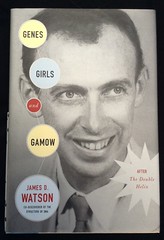
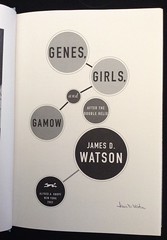
To read the earlier E-Sylum article, see:
JAMES WATSON'S 1962 GOLD NOBEL PRIZE MEDAL
(www.coinbooks.org/esylum_v17n49a23.html)
THE BOOK BAZARRE
BONHAMS TO OFFER EXPERIMENTAL ULTRA HIGH RELIEF $20
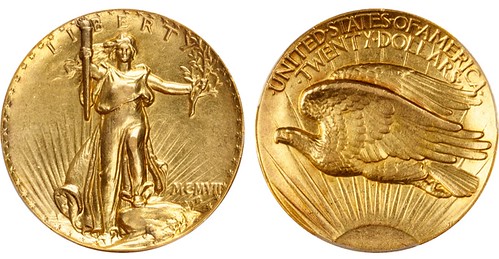
An extremely rare 1907 Saint-Gaudens Ultra High Relief $20 featuring an early production Sans Serif lettered edge will go under the hammer on December 16, 2014 (est. $1,250,000 - $1,500,000) at the Coins and Medals auction.
The collar’s Sans Serif font that was used on the edge of the earliest Ultra High Reliefs distinguishes this coin as one of the first struck. It is also known as the Type of 1906, and only one other example is known with this edge feature. Another interesting fact about the edge is that the collar impresses the lettering in an inverted fashion. Between February 7th and 14th in 1907, the first four experimental Ultra High Relief $20 coins, including this coin, were struck at the Mint in Philadelphia.
Paul Song, director of the Los Angeles based department, states, “This coin is an old friend of sorts. Earlier in my career in 1992, I discovered this coin variety for the first time at an East Coast estate and sold it at auction for $143,000. Almost 25 years later, I am pleased to place it on auction again. Close examination of the edge revealed lettering without serifs—the same style that was used in 1906 to create the Judd-1992 $20 gold pattern. No one had ever thought to look at the edge or the collar of an Ultra High Relief before. "
It is almost certain that this is the first Ultra High Relief ever struck. The light rubbing on the surfaces could easily be the result of this coin being personally examined by Mint officials and even by Theodore Roosevelt himself, just after striking. The design and inspiration of the 1907 Ultra High Relief and later standard High Relief are legendary, and this particular coin design has been widely touted as the most beautiful coin ever produced by the United States Mint—a testament which is certainly reinforced by the fact that this basic design is still in use by the United States Mint for its coinage today, over a century later.
I asked researcher Roger Burdette about this. He writes:
I see no evidence presented by Bonhams to support the above statement. Without supporting documentation the above is nothing but speculation. Given the brief description, all that can be said is the coin was likely one of the first group struck.
To read the complete article, see:
Bonhams
in New York to offer possibly the first struck 1907 Ultra High Relief $20 coin
(http://artdaily.com/news/74870/Bonhams-in-New-York-to-offer-possibly-the-first-struck-1907-Ultra-High-Relief--20-coin#.VIMbgjEVhYE)
ON MEDALS ISSUED AFTER THE ARTIST'S DATE OF DEATH
In his remarks last week about U.S. Mint engraver Engelhardus von Hebel, Dick Johnson wrote:
In 1949 he engraved only the seal on the reverse of the Harry Truman Presidential Medal (List 132), while John R. Sinnock did the obverse, Gilroy Roberts did the rest of the reverse.
Roger Burdette writes:
Sinnock died in 1947, so it is unlikely he did much with the Truman presidential medal. Roberts did most of the work.
HOW CAN AN ARTIST DO A MEDAL TWO YEARS AFTER HE DIES?
Roger Burdette raises an interesting question about Chief Engraver John R. Sinnock. He states Sinnock died in 1947. True. He is credited with the obverse portrait of Truman on a medal issued in 1949. Also true.
Sinnock's ghost was not creating medals in the engraving room of the Philadelphia Mint after the good engraver had passed on. The answer was so simple I was baffled until I realized the 1949 Truman Medal was for his Second Term.
The Mint used his portrait from Truman's First Term Medal which Sinnock did both sides in 1945. The Mint took a shortcut by using the existing Sinnock portrait, creating a new reverse, by Gilroy Roberts and Engelhardus von Habel, mentioned in last week's E-Sylum.
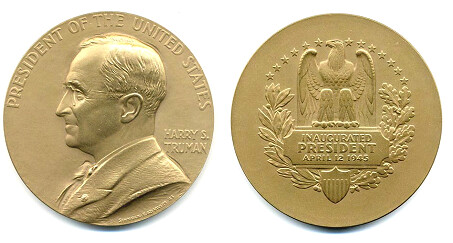
Harry Truman Medal. Image courtesy Joe Levine.
But there ARE instances of medals issued a year or two after an artist's death. Most prominent examples are two of Laura Gardin Fraser's work. her two Hall of Fame Series medals.
She died in 1966. Her Mary Lyon Medal was issued in 1967. Her Gilbert Stuart Medal was issued in 1968. Her models were only half done at the time of her death. The models were retrieved from her studio and assigned to sculptor Karl Gruppe to complete them. To his credit he retained her original design concept and modeled them in her sculptural style.
There are other instances -- too many to mention -- where dies have been engraved, or models completed, but were not issued until a later date. For many reasons, from lack of funds to change of a medal program.
The artist's date of death is vitally important, which Roger undoubtedly had in mind in his comment. I have attempted to learn the date of death of every artist in my artists databank. Those listed after the artist's date of death are in a category I call "Replicas & Reissues."
Medals in which a portrait, device, or other pictorial element is repeated -- copied, if you wish -- on a later medal falls in this category. Medallic artists frequently look to previous medal designs for inspiration. If the replication is too close it is indeed a replica. If the medal is exact for both sides, it is a reissue.
Houdon's bust of Washington is perhaps the most copied portrait in American medals. I have record of 60 medals with his famous relief portrait depicted.
But for Laura Gardin Frasers' two Hall of Fame Medals I list among her work while she was alive. I also give credit to Karl Gruppe for finishing her models.
To read the earlier E-Sylum article, see:
U.S. MINT ENGRAVER ENGELHARDUS VON HEBEL (www.coinbooks.org/esylum_v17n49a17.html)

LIBERTY DOLLAR CREATOR BERNARD VON NOTHAUS SENTENCED
Tuesday morning at 9:30, a federal judge in North Carolina will gavel his court into session to pronounce a sentence on Bernard von NotHaus. A monetary gadfly in an age of fiat money, Mr. von NotHaus, 70, could be looking at the rest of his life in prison.
Nearly four years ago, a jury convicted Mr. von NotHaus of “uttering”—putting into circulation—coins of pure silver that he called Liberty Dollars. The government is also seeking the forfeiture of 16,000 pounds of coins and precious metals whose value it reckons at $7 million.
The federal prosecutor, Anne Tompkins, put out a news release stating that “attempts to undermine the legitimate currency of this country are simply a unique form of domestic terrorism” and “represent a clear and present danger to the economic stability of this country.”
This is something to think about at a time when the China, the Europeans, the United Nations and various leaders of the World Bank are wondering whether we need a new or better reserve currency. And when Congress is fizzing with disquiet about the dollar.
Mr. von NotHaus suggests that likening him to a terrorist is absurd. “This is the United States government,” he told the New York Times two years ago. “. . . it has nuclear weapons, and it’s worried about some ex-surfer guy making his own money? Give me a break.”
To read the complete article, see:
A Monetary Gadfly in an Age of Fiat
Money (http://online.wsj.com/articles/seth-lipsky-a-monetary-gadfly-in-an-age-of-fiat-money-1417478381)
A former Evansville businessman is sentenced to six months house arrest. Bernard von NotHaus was convicted in 2011 of counterfeiting charges for minting and distributing a form of private money called the Liberty Dollar. Authorities say von NotHaus created Liberty Dollar Services based in Evansville, to mint a currency he called the Liberty Dollar. It was supposed to rival the US dollar.
Von NotHaus had been facing up to 40 years in prison and the possible forfeiture of millions of dollars.
To read the complete article, see:
Liberty
Dollar Founder von Nothaus Sentenced to House Arrest for Counterfeiting
(www.tristatehomepage.com/story/d/story/liberty-dollar-founder-von-nothaus-sentenced-to-ho/17589/F7ET48RAY0yE7MuvzXcGwQ)
Congratulations are in order to United States District Judge Richard Voorhees of North Carolina for the judiciousness of his decision in the case of Bernard von NotHaus. We weren’t personally present at the courthouse at Statesville, where von NotHaus had been ordered to appear Tuesday for sentencing on his conviction of uttering — introducing into circulation — his Liberty Dollars. But we were on tenterhooks, because von NotHaus, 70, was looking at the possibility of spending the rest of his life in prison.
In the three and a half years since the jury reached its decision, Judge Voorhees allowed constitutional and procedural objections to be heard but in the end supported the jury. The government on Tuesday asked for a prison sentence of at least 14 years and as much as 17 ½ years. The government was also seeking forfeiture of some 16,000 pounds of Liberty Dollar coins and specie, which in 2011 it had valued at nearly $7 million.
Then spake the judge, sentencing von NotHaus to but six months of home detention, to run concurrently with three years of probation. He departed from non-binding guidelines because, he suggested, von NotHaus had been motivated not by criminal intent but by an intention to make a philosophical point. That is what these columns have been reporting for more than four years, and, while the Sun’s coverage played no part in the case, we are glad to discover that the judge is of a similar, if not identical, mind.
Von NotHaus is no doubt relieved that he doesn’t have to go to jail, but he has put out no statement. Our guess is that it is sinking in on him that he has been marked now as a felon, and his own dream of a parallel form of money, composed of constitutional specie, is gone. There may yet be surprises, but the sagacity of Judge Voorhees’s handling of this case lies in, among other elements, the fact that he has left no great incentive for either side to make an appeal.
To read the complete article, see:
Beyond Bernard von NotHaus
(www.nysun.com/editorials/beyond-bernard-von-nothaus/88958/)
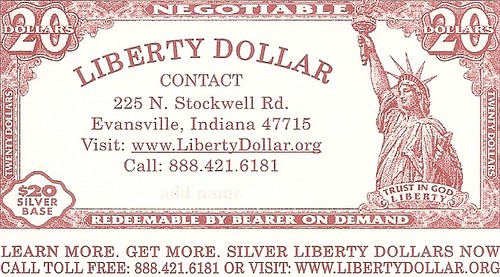
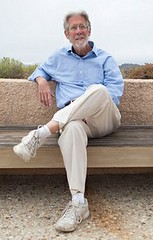 This has been a loooong time coming. While I'm no fan of the hard money movement, I too
agree with the decision. As I'd written back in March 2011: "While I don't disagree that Von NotHaus was basically running a scam, the
government is a little over the top in their accusations. Terrorism? Really? Get a grip. "
This has been a loooong time coming. While I'm no fan of the hard money movement, I too
agree with the decision. As I'd written back in March 2011: "While I don't disagree that Von NotHaus was basically running a scam, the
government is a little over the top in their accusations. Terrorism? Really? Get a grip. "
Below is a related excerpt from December 23, 2012, when eBay and the Central States Numismatic Society banned Liberty Dollars from their venues.
There may be a small collector community for Liberty dollars, but no powerful hobby voices with a vested interest. But if Liberty Dollars are banned, what about other alternate currencies, past and present? Are Ithica Hours counterfeits? What about Nickolas Veeder's Eutopia dollars or Lewis Feuchtwanger's issues? They were proposed alternative coins, too.
Their issuers were never accused of counterfeiting like Liberty Dollar maker von Nothaus, of course. With his wink-wink-nudge-nudge marketing spiel he built a multilevel army of distributors and shovers who eagerly bought the coins at a discount and resold or spent them at a profit. It was a scam masked as a political statement, and deserved to be shut down. But it's not the coins' fault. Von Nothaus may end up in jail, but his coins shouldn't be imprisoned as well. They are now historical artifacts deserving of a place in numismatic collections.
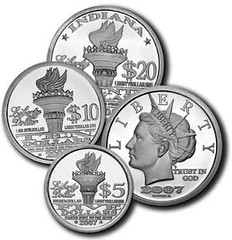 If you ask me, the prosecution's case against von Nothaus is like the
tax-evasion gambit that put Al Capone behind bars. They couldn't get him on racketeering charges, but nailed him for tax evasion instead. With
von Nothaus they couldn't find a crack in his free speech shield, but instead made a claim that his coins were counterfeits, even though they
were no more likely to be mistaken for an official U.S. coin than a Chuck E. Cheese token. Seriously, do these look like counterfeits to you? I feel
compelled to state that the above opinions are mine alone, and do not reflect a position of NBS.
If you ask me, the prosecution's case against von Nothaus is like the
tax-evasion gambit that put Al Capone behind bars. They couldn't get him on racketeering charges, but nailed him for tax evasion instead. With
von Nothaus they couldn't find a crack in his free speech shield, but instead made a claim that his coins were counterfeits, even though they
were no more likely to be mistaken for an official U.S. coin than a Chuck E. Cheese token. Seriously, do these look like counterfeits to you? I feel
compelled to state that the above opinions are mine alone, and do not reflect a position of NBS.
And numismatically speaking, will Liberty Dollars be un-banned from eBay and the Central States shows? Have any other shows implemented such bans? -Editor
To read earlier E-Sylum articles, see:
LIBERTY DOLLAR CREATOR CONVICTED IN FEDERAL COURT
(www.coinbooks.org/esylum_v14n12a20.html)
LIBERTY DOLLAR FOUNDER VON NOTHAUS AWAITS HIS FATE
(www.coinbooks.org/esylum_v15n45a11.html)
CENTRAL STATES NUMISMATIC SOCIETY BANS LIBERTY DOLLARS
(www.coinbooks.org/esylum_v15n53a13.html)
DO LIBERTY DOLLARS DESERVE TO BE BANNED? (www.coinbooks.org/esylum_v15n53a14.html)
LIBERTY DOLLAR CREATOR TO BE SENTENCED (www.coinbooks.org/esylum_v17n47a27.html)
SOME ELECTROTYPES AND CONTEMPORARY COUNTERFEITS
Electrotype of a Dickeson Restrike Token

“1792” (Circa 1859) Electrotype of a Dickeson Restrike Token, Uncirculated [uncertified]. Breen-1380, Judd-C1792-1. A handsome red & brown "coin", and well made for an electrotype. The obverse features a defiant eagle perched on a rock. The reverse displays the legends "TRIAL PIECE/DESIGNED FOR/UNITED STATES/CENT./1792." According to Walter Breen's 1988 Encyclopedia, Dr. Montroville Wilson Dickeson obtained a pair of dies created by early mint employee Adam Eckfeldt. These dies were never used for coinage or pattern purposes, and were likely sold as scrap metal by the mint. Dickeson apparently believed the die was connected with the 1792 Getz or Birch cents. I never saw or heard of one of these when I was collecting electrotypes of colonial and early American coinage, so I was surprised to see this piece. $495
1858 Liberty Quarter Eagle Contemporary Counterfeit

1858 Liberty Quarter Eagle Contemporary Counterfeit. Almost Uncirculated [uncertified]. Spectacular condition for a contemporary counterfeit coin. $200.
1861 Three Cent Silver Contemporary Counterfeit

1861 Three Cent Silver Contemporary Counterfeit. Almost Uncirculated [uncertified]. Another extremely high quality example of this popular contemporary counterfeit type. You can't see it in the images, but there is actual cartwheel luster on this coin. $195.
1888-S Liberty Half Eagle Contemporary Counterfeit
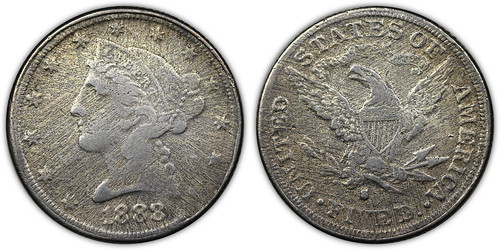
1888-S Liberty Half Eagle Contemporary Counterfeit. Very Fine [uncertified]. This coin is also been similarly abused. Still rare, and coins like this (which are the norm in the contemporary counterfeit world) make one appreciate seeing a truly high grade example. $95
For more information, see Dave's web site:
www.davewcoins.com/
THE BOOK BAZARRE
SELECTIONS FROM THE DIX NOONAN WEBB FEBRUARY 2015 SALE
Two major numismatic rarities will be among the highlights of the auction of Ancient, British and World Coins, Tokens and Commemorative Medals to be held by Dix Noonan Webb, the international coins and medals specialists, in London on 11 February 2015. A newly-discovered Australian George V 1921 Proof Shilling with a star above the date, one of just six minted, is expected to fetch £100,000 to £120,000.
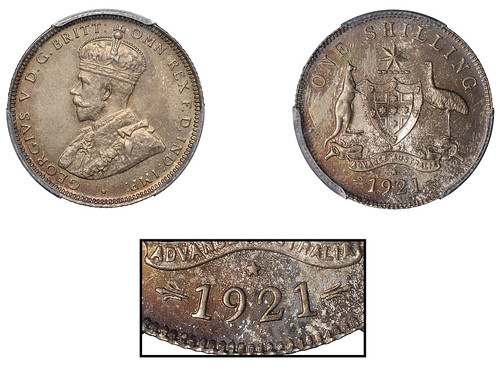
One of only two known George V 1910 Pattern Crowns in gold designed by A.G. Wyon is estimated at £80,000 to £100,000.
“These are very exciting coins to include in our auction,” says Christopher Webb, head of the coins department at Dix Noonan Webb. “The Australian 1921 Proof Shilling has lain un-noticed in a private collection for decades and we cannot trace any example of this coin having been offered for sale within the last 30 years. The George V Pattern Crown is excessively rare and comes with a distinguished provenance.”
The Australian 1921 Proof Shilling bearing the crowned head of George V and with a small star above the date was an indirect result of the economic upheaval in the aftermath of the First World War. The price of precious metals rose and it was decided to reduce the silver content of British coins. It was intended that the same should be done with the Australian silver coinage and dies dated 1920 and 1921 were produced with a small star above the date. This was not strictly a mintmark but was intended to differentiate the new lower quality coins.
In fact the change in silver content was never implemented in Australia but 30 pairs of working dies with stars had already been dispatched to the Sydney mint from London in October 1920 and these were used to produce the 1921 coinage. The star-marked coins were only ever minted in small quantities – 522,000 currency coins and just six specimen or proof strikings. Of the six proofs produced, two are in the collection of the Museum of Victoria in Melbourne. Both are inferior in condition to the one to be auctioned at Dix Noonan Webb. The latter is in virtually mint state and lightly toned.
The 1910 George V Pattern Crown in gold designed by A.G. Wyon is one of only two known specimens and is expected to sell for £80,000 to £100,000 at Dix Noonan Webb. When the British king Edward VII died in May 1910, plans for new coins bearing the head of his successor George V were put into place long before the latter was formally crowned at Westminster Abbey in London in June the following year. A number of designs were submitted to the authorities for approval, one of which was by A.G. Wyon, a member of a dynasty of designers and engravers which had played an important role in British public life for more than a century.
Wyon’s design had the bare head of the new king facing left on the obverse while the reverse depicted St George on horseback spearing a dragon with the date below. The George V gold Pattern Crown, 1910 , by A.G. Wyon is estimated at up to £100,000
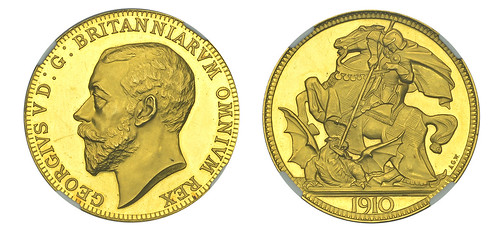
Despite his illustrious family pedigree, Wyon’s design was not chosen so his Proof Crown in gold bearing the date 1910 – the year before George officially became king – became a numismatic rarity rather than standard currency. Only two examples are known and the coin to be auctioned at Dix Noonan Webb is in virtually mint state. It has been in a number of important collections over the past century including those assembled by G. Hamilton-Smith, Sir Kenyon Vaughan Morgan, Lady Duveen and C. Dabney Thompson.
For more information, see:
http://www.dnw.co.uk/
1830 PHILIPPINES MANILA OVERSTRIKE 8 REALES
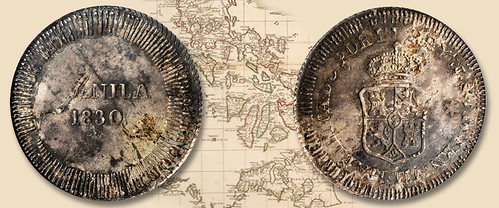
All collectors of Philippines coins will be watching during the Stack’s Bowers Galleries New York International Numismatic Convention Sale as we present the Ray Czahor Collection of items related to this historic and sometimes overlooked area. The Philippines have a very interesting history, being a colony of the Spanish Crown for two centuries, before being taken over by the United States in 1901.
Various Philippine coinages were issued, starting with locally issued base metal coinage, and continuing with counterstamped Spanish colonial issues, copper, silver and gold coins struck in Madrid for use in the Philippines, coins struck in San Francisco and Philadelphia while under the U.S. Administration, and finally in the Philippines themselves when the mint in Manila was opened in 1920. Our sale will present coins from each of these eras and will serve as a reference in the series for years to come.
This week we focus our attention on one of the most important silver coins in the offering — the finest certified Manila Overstrike 8 Reales from the decree of January 16, 1832. This coin is graded by NGC as MS-63, and is pedigreed to the Cornelius C. Vermeule III Collection and was sold in our (Stack’s) International Numismatic Sale, January 13, 2004, lot 933. It was then sold as lot 914 in the May 2008 Goldberg sale of the Millennia Collection. This coin has been a highlight and provided pride of ownership to its current owner, and it will surely be the centerpiece in an advanced collection of world crowns or a specialized collection of Philippine coinage. Nothing more can be added to our expert description, which appears below in its entirety.
Lot 1366
Finest Certified 1830 Manila Overstrike
PHILIPPINES. 8 Reales, 1830 (Decree of January 16, 1832). KM-35; Basso-39; cf.PNM#6-19; cf.PNM#16-2; Cacho-Type II CS-001; Lopez-Chavez Yriarte-Type I. Type IV Manila overstrike, with serrated borders and reverse legend; dies prepared by Don Benito de los Reyes. Overstruck on an 1829-PTS JM Bolivia 8 Soles. VERY RARE as a date with an estimated 20-25 examples known (some of which are in institutions) and the key to the Philippine countermark series.
EXTREMELY RARE in this state of preservation. The finest graded by either PCGS or NGC, and certainly one of the finest known to exist, if not the finest.
"MANILA" somewhat obscured from the portrait of Bolivar with only "NILA" fully struck up and full four digit date with dot between and below, serrated border fully struck nearly obliterating the host coin’s legend with only minor details still visible; Reverse: Crowned arms of Spain nearly fully struck up with only the slightest bit of weakness in the border of the shield at top right side, virtually all aspects of the legend are clear with scattered weakness and a minor portion between 3 o'clock and 4 o'clock which is indistinct, full serrated border nearly obliterating the host coin’s legend.
The striking of the 1830 issue was delayed due to frequent breakdowns of the coin stamping machine made by foundry master Benito de los Reyes, who also produced all of the "MANILA" dies. On May 30, 1829, the authorities closed the countermarking office because of these frequent breakdowns and began looking for an alternative. It was recommended that a new stamping press made of tempered steel be ordered from Calcutta or Batavia. After learning that the authorities were looking to purchase a new press, Jose Campana wrote to them on September 18, 1829, offering to sell a similar press that was purchased from Bengal, India for 5,500 pesos. Before the purchase of this new press could be consummated Campana had to agree to install and test the new machinery by re-stamping no less than 1,000 pesos worth of coins.
On January 29, 1830, Campana informed the authorities that the new Bengal press was stored in the warehouse of Don Andreas Camba and ready for testing, but had no dies. He requested that the old dies be modified for the new machine or a new set of dies be produced. Since the old dies could not be modified to fit the new machine, approval was given March 9, 1830, to Benito de los Reyes for the production of new dies. Finally on May 28, 1830, testing of the new press had taken place, but only 400-500 pesos were re-stamped. After inspection was accomplished and reports of the output production of the new press given to the authorities, on November 29, 1830, Campana received a counteroffer of 4,000 pesos. He accepted the offer on December 20, 1830.
On February 4, 1831, the new press had arrived from Calcutta and was to be installed on a solid base in the same area as the previous press. Installation of the new press began on March 3, 1831, but it wasn't until the reply to the decree of January 7, 1832, on January 16 that approval and re-stamping began. Since the coins were no longer being heated, softened and flattened with a hammer prior to being overstruck, the hardness of the coins effaced the new dies easily and caused the new press to break down within 15 days of operation. Overstrike very well executed for issue with only minute details of the under type visible. Grey mottled toning with faint hues of azure, lustrous in the serrated border. NGC MS-63.
Ex: Millennia Collection, May 26, 2008 Lot #914.
Ex: Cornelius C. Vermeule III Collection, our (Stack’s) International Numismatic Sale, January 12, 2004, lot #933.
To read the complete article, see:
Finest Certified Philippines Manila Overstrike 8 Reales of 1830 (Decree of January 16, 1832) Highlights a Strong Offering of Philippine Coinage
(www.stacksbowers.com/NewsMedia/Blogs/TabId/780/ArtMID
/2678/ArticleID/64877/Finest-Certified-Philippines-Manila-Overstrike-8-Reales
-of-1830-Decree-of-January-16-1832-Highlights-a-Strong-Offering
-of-Philippine-Coinage.aspx)
CHRISTUS VITAE COLLECTION OF SHEKELS FROM THE LIFETIME OF JESUS
PHOENICIA. Tyre. 126/5 BC-AD 65/6. Collection of 38 AR shekels spanning the lifetime of Jesus Christ, circa 5 BC – AD 33/4. Dated from Civic Year 122 (5/4 BC) to Civic Year 159 (AD 33/4). All of general type bust of Melqart right, wearing laurel wreath, lion-skin around neck / TYPOY IEPAS KAI ASY?OY, Eagle standing left on prow, palm frond over wing; to left Civic Year date (in Greek letter-numerals) above club; to right, KP above monogram; Phoenician letter indicating officina between legs.
Individual dates, weights are provided below. Attributions are by Roman Provincial Coins Vol. I and Vol. I supplement, and by Dated Coins of Antiquity Vol. 1 (Ed Cohen-CNG, 2011) and DCA Supplement: Shekels of Tyre (Cohen-CNG, 2014). Rarity ratings are according to DCA 1 and are as follows: C = Thousands of known specimens; S = 500 to 2,000 known specimens; R1 = 25 to 500 known specimens; R2 = 2 to 25 known specimens; R3 = 1-2 known specimens; U = Unreported. DCA Supplement: Shekels of Tyre updates the rarity assessment (at least one example was found for most of the issues listed as U in Volume 1). The number of specimens cited in both RPC and SCA supplement are provided when available.


Date PKB, Year 122 (5/4 BC)
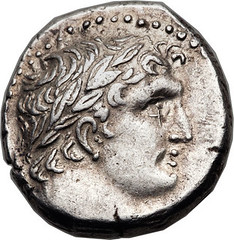
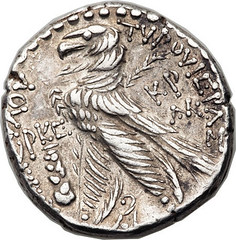
Date PKE, Year 125 (2/1 BC)
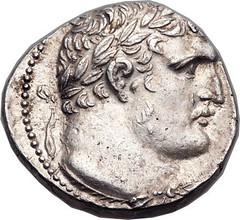
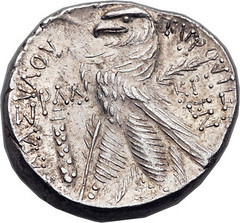
Date P?A, Year 131 (AD 5/6)
This extraordinary set of 38 dated shekels of Tyre, the main silver coinage of the Holy Land in New Testament times, spans the putative lifetime of Jesus of Nazareth and is the only collection of its type ever assembled. Hence we are justified in calling it "The Collection of a Lifetime." The collection was assembled by noted numismatist and antiquarian Frank Kovacs of Corte Madera, California over a 25-year period from 1990 to the present. Widely known as an expert on dated coinages of the Classical East (including Armenia, Judaea, Syria and Phoenicia), Frank's extensive contacts provided him the opportunity to acquire several newly discovered dates that still survive only singly or in tiny numbers (fewer than five known examples). At least one coin in the collection (number 33, dated Year 154 / AD 28-29), is thought to be unique. Thus this collection would be impossible to duplicate until more examples come to light.
The Lifespan of Jesus:
Even without taking up the question of his divinity, Jesus of Nazareth, widely known as Jesus Christ, is arguably the most important person in the
history of Western Civilization. Indeed, the modern world's BC / AD dating system is based on his assumed birth year of 1 BC/AD 1 (there is no
"year zero"). This dating system is based on the calculations of Dionysius Exeguus in about AD 525; however, modern scholars have concluded
that Jesus was actually born a few years earlier, probably 5-4 BC.
Establishing the actual lifespan of Jesus is thus an uncertain exercise at best, as the Gospel accounts contain no detailed time line and the actual dates that are mentioned are frequently contradictory. However it is possible to set the broad goalposts between which Jesus must have lived, using the earliest widely accepted year for his birth, 5/4 BC, and the latest likely date for his Crucifixion, AD 33/4.
Shekels of Tyre:
The Phoenician port city of Tyre rose to prominence in the tenth century BC as an international trade center, becoming wealthy from its export of a
deep purple dye made from a mollusk, the famous "Tyrian purple" worn by royalty. It maintained good relations with the Kingdom of Israel
and even helped finance the construction of Solomon's temple circa 971-931 BC. It became a Persian vassal in 539 BC and, after a legendary siege,
fell to Alexander the Great in 332 BC. Tyre was fought over by the successor Ptolemaic and Seleucid Kingdoms for another two centuries before finally
regaining its independence in 126 BC. From this year, Tyre began issuing silver coins, shekels and half-shekels, that were widely accepted in the
Levant as a trade currency due to their carefully controlled weight and fineness. Tyrian shekels carry the obverse image of Melqart, a Phoenician
version of Heracles, and a reverse depiction of an eagle standing left on the prow of a ship, palm branch tucked under its right wing, with a club
(of Melqart / Heracles) in the left field. The reverse legend translates to "Of the Holy and Inviolable City of Tyre" and in the left field
is a date in Greek numerals, counting years forward from the date of the city's autonomy (126/5 BC). Other letters and monograms identify the
responsible mint magistrates; a Phoenician letter aleph or bet between the eagle's legs most probably indicate the office or workshop where the
coin was struck.
Lacking a silver currency of its own, the newly independent kingdom of Judaea came to accept the use of Tyrian silver as the main coin of the realm. Tyrian shekels and half-shekels were the only coins acceptable as tithes and payments to the Temple in Jerusalem, which was vastly expanded by Herod the Great (37-4 BC). This situation maintained after the Romans gained direct control of Judaea after Herod's death.
After 20/19 BC, the style and fabric of Tyrian coinage changed markedly, with the coins becoming smaller and thicker, and the letters KP were added to the reverse control marks. The noted Israeli numismatist Ya'akov Meshorer proposed that these later shekels were actually minted in Jerusalem rather than Tyre, based on hoard evidence that the coins circulated far more heavily Judaea than in neighboring Phoenicia. While this view is not widely accepted, it is clear these later shekels were minted primarily to meet burgeoning demand in Judaea and surrounding regions. Edward Cohen, author of "Dated Coins of Antiquity," notes that the date form of the later shekels (consistently reading left-to-right) differs from the earlier issues and indicates a different mint in the southern Levant. These "KP" shekels were evidently minted more sporadically, and in smaller numbers, than earlier issues and are generally much rarer today; in fact coins are unknown for several of the years between 20 BC and AD 66, when their issue ceased. Other years are known from only a single specimen or a handful of examples.
The Tyrian shekel features prominently in many Gospel accounts, most notably the scene in which the Apostle Judas betrays Jesus to the Temple authorities and is "covenanted" with "30 pieces of silver." These were certainly shekels of Tyre. In another scene (Matthew 17:24-27), Jesus plucks a shekel from the mouth of a fish to pay his Temple tax. The famous incident where Jesus attacks the "money changers" in the Temple courtyard likely resulted in many Tyrian shekels flying about, as this was the currency into which visitors were changing their own native coins.
Since Tyrian shekels were the only large silver coins to circulate heavily in the Judaea, Samaria, Galilee and the Decapolis, the very regions Jesus of Nazareth frequented during his itinerant ministry, the question must be asked: What are the chances that Jesus himself, or one of his disciples, or one of the other figures mentioned in the Gospels, actually touched or held one of the coins in this collection?
To read the complete lot description, see:
PHOENICIA. Tyre. 126/5 BC-AD 65/6. Collection of 38
(http://coins.ha.com/itm/ancients/judaea/phoenicia-tyre-126-5-bc-ad-65-6-collection-of-38-ar-shekels-spanning-the-lifetime-of-jesus-christ-circa-5-bc-ad-33-4/p/3037-60001.s)

MOSQUES DEPICTED ON PROPOSED ISLAMIC STATE COINS
Adding to the thoughts of Mr. Alexander on the possible coin issues attributed to the Islamic State, the mosques on two of the coins were incorrectly identified. I tread lightly when trying to discuss religions, but following is my attempt as the two buildings and areas on which they sit have significance to those of the Jewish, Christian, and Islamic faiths and show their inter-relationships in this part of the world of conflicting histories and so much emotion:

 The
ten dirham coin illustrates the al-Aqsa Mosque. The Old City of Jerusalem contains the raised ground known by Jews and most Western Christians as the
Temple Mount and by Muslims as al-Haram ash-Sharif (Noble Sanctuary). According to Jewish tradition and scripture, the Temple Mount is the location
of the Second Temple, destroyed by the Romans in 70 AD. The prominent structures visible today on the Temple Mount/Noble Sanctuary are the Al-Aqsa
Mosque and the Dome of the Rock, both of which I have visited.
The
ten dirham coin illustrates the al-Aqsa Mosque. The Old City of Jerusalem contains the raised ground known by Jews and most Western Christians as the
Temple Mount and by Muslims as al-Haram ash-Sharif (Noble Sanctuary). According to Jewish tradition and scripture, the Temple Mount is the location
of the Second Temple, destroyed by the Romans in 70 AD. The prominent structures visible today on the Temple Mount/Noble Sanctuary are the Al-Aqsa
Mosque and the Dome of the Rock, both of which I have visited.
The two buildings can be confused as the whole area of the Noble Sanctuary can be referred to as al-Aqsa Mosque. The Dome of the Rock has an octagonal shaped plan and with its golden dome is one of Jerusalem’s most recognizable landmarks. I consider the Dome of the Rock to be one of the most beautiful buildings in the world that I have ever entered. According to tradition of many, it sits on the site from which Mohammad ascended to heaven. The Dome of the Rock is not a mosque for worship but a shrine for pilgrimage. The adjacent al-Aqsa Mosque is a congregation mosque where Muslims pray and is the rectangular building depicted on the coin.

 Based on the two covered galleries in the main body of the minaret and the two projecting galleries
on the spire, the five dirham coin depicts the Minaret of Prophet Isa (Jesus), one of three minarets at the Umayyad Mosque, also known as the Grand
Mosque of Damascus. Muslims do not believe Jesus died on the cross but was raised by Allah to heaven and at the end of time he will return to earth
at this place.
Based on the two covered galleries in the main body of the minaret and the two projecting galleries
on the spire, the five dirham coin depicts the Minaret of Prophet Isa (Jesus), one of three minarets at the Umayyad Mosque, also known as the Grand
Mosque of Damascus. Muslims do not believe Jesus died on the cross but was raised by Allah to heaven and at the end of time he will return to earth
at this place.
The Umayyad Mosque is one of the largest and holiest mosques in the world and in a garden adjoining the mosque is the tomb of Saladin. What I found remarkable on my visit was the veneration here for John the Baptist (Prophet Yahia to Muslims). As the mosque is the site of an earlier Christian basilica, tradition says that his head is buried here. Allegedly this is the first mosque ever entered by the Roman Catholic Pope, occurring when Pope John Paul II came to Damascus in 2001 to visit the relics of John the Baptist.
To read the earlier E-Sylum article, see:
ALEXANDER ON THE "ISLAMIC STATE" COINS
(www.coinbooks.org/esylum_v17n49a25.html)
VENDING MACHINE INDUSTRY FIGHTS NEW £1 COIN
It is designed to be a counterfeiter’s nightmare, but it seems that would-be forgers are not alone in dreading the arrival of the new £1 coin. The attempt to spike a £45 million-a-year forgery racket will wreak havoc on parking meters, drinks machines and one-armed bandits, company chiefs claim.
The 12-sided coin announced by George Osborne in September will be made from two types of metal and, like the existing £2 coin, will be of two colours. It is designed to look like the classic threepenny bit last minted in 1970, but its shape and high-tech security features, designed to foil criminals, pose a headache, too, for the makers of coin-operated machines.
Bacta, the body that represents the amusement industry, believes that it could cost £100 million to adapt 350,000 fruit machines and poker terminals — a sum that cannot be passed on to customers because of strict rules governing the ratio between stakes and winnings.
The British Retail Consortium is worried that supermarket self-service tills will need to be adapted, while the Automatic Vending Association says that it will cost £72 million to adapt every coffee, snack and fizzy drinks machine.
“It was only in 2011 that we had to make changes for the new 5p and 10p pieces,” Jonathan Hilder, chief executive of the Vending Association, said. “What we’re saying to the government is we’d like a bit of help here. We’re making these changes to ensure that a coin of the realm is protected from forgeries.”
The Treasury wants to ditch existing £1 coins because of a surge in counterfeiting. It estimates that fakes make up 3.03 per cent of £1 coins in circulation, a proportion that has trebled over the past decade, accounting for a value of £45 million.
Government officials say that the 30-year lifespan of the existing design is much longer than usual for modern coins and that the “price would be high” if confidence deteriorated in pound coins.
THE BOOK BAZARRE
A BRIEF HISTORY OF THE MONEYMUSEUM
A Brief History of the MoneyMuseum and Sunflower Foundation Coin Collection
By Dr. Ursula Kampmann
PANTA RHEI – “everything flows.” This quote from the work of the Greek philosopher Heraclitus perfectly encapsulates everything the MoneyMuseum strives to be–always changing, never resting on the laurels of its past, and always remaining in the lead when it comes to the challenge of seeking out new forms of communication.
This is why the MoneyMuseum is selling another portion of its collection. The proceeds will go toward financing a brand new chapter of the MoneyMuseum: a multimedia presence on iTunes University.
A debut on the Internet
It all began with 500 coins privately amassed by Dr. Jürg Conzett. Leo Mildenberg oversaw the collection right until his death, which is one of the
reasons for the outstanding quality of the Greek coinage, in particular.
But the owner of this collection traveled so often, he barely had a chance to hold the coins in his own hands–for Jürg Conzett, the Internet offered a solution. He put his collection on the Net at moneymuseum.com (now found at http://sunflower.ch/en/moneymuseum/museum), both for himself and for anyone else who might be interested in it. In April 1999, the MoneyMuseum went online, and interest did indeed prove great, since at the time, although perhaps hard to imagine today, it was the first institution to make a large volume of coin photos available on the Internet.
In 2014, the MoneyMuseum had 2,600 coins in its possession. In terms of numbers, it cannot compete with the large institutions, of course, but it’s not the quantity of objects that interests Jürg Conzett.
Instead, the aim of his MoneyMuseum is to make visitors think about money–about its history, but also about its future. For this reason, there are no conventional or traditional types of coin exhibits. The focus here is on the issues and questions raised by our past. An exhibit about gambling may well finish with a station where visitors have to vote on whether gambling on the stock market can in fact be considered “gambling.” And the exhibition installed for 2015 is dedicated to the question of how the denarius made world history. Every visitor will vote on what role money plays in decisions on war and peace–not only in Republican Rome, but also in the United States and the European Union.
The Sunflower Foundation
Since June 1999, the Sunflower Foundation–also started by Dr. Jürg Conzett–has been responsible for presenting the MoneyMuseum’s collection. But the
founder and current head of the MoneyMuseum actually comes from a completely different background than what you might expect. He completed his degree
in history and psychology at the University of Zurich in 1972, and then went on to graduate from the prestigious School of Management at Stanford
University. He worked as a financial analyst in New York, Tokyo, and Zurich. His constant dealings with money piqued his curiosity as to the
relationship between man and money–to what extent has money influenced our history? And to what extent does it continue to exert its influence today?
And how should money look in the future in order to be able to bring about a better, more humane and just economy?
These questions are reflected in the objectives set by the Sunflower Foundation:
1) To present the history of Western money from its beginnings right through to the middle of the 20th century, using the latest techniques and a
superior quality coin collection illustrated through superb digital photographs.
2) To display alternatives to our society’s currently accepted money model.
3) To promote an open and relaxed approach to the topic of money.
From a virtual to a real museum
The MoneyMuseum is a dynamic project that is constantly changing and evolving. Everything is temporary and in flux. And so, by the year 2000, the
virtual Internet MoneyMuseum opened its first real branch on the premises of the Swiss National Museum. In 2002, the MoneyMuseum opened its first
proper permanent exhibition on the history of money in Zurich in the museum on Bärengasse, a branch museum of the Swiss National Museum. In February
2003, the MoneyMuseum was inaugurated on Hadlaubstraße. And in 2014, everything changed yet again when the museum on Hadlaubstraße reopened after
renovations.
Discussion Forum and Platform
One thing, however, will remain the same–the MoneyMuseum’s focus always remains on the big picture. The ultimate aim is to offer visitors food for
thought about their own relationships with money. And to do so, the MoneyMuseum has always pursued new methods of conveying this information, be it
through audio dramatizations, DVD presentations, or films. Everything is geared toward the layperson as well, not just numismatic connoisseurs.
Part and parcel of this as well are the unconventional contexts in which the MoneyMuseum places money–the well attended lectures include themes as diverse as “money in literature,” “money in psychiatry and psychotherapy,” or all the way to “your money personality–your writing.” There are historical lectures too, of course, but the history serves not as an end in and of itself, but rather a backdrop against which the present must be compared.
Social Responsibility and Cyclos
Just being a museum and a platform isn’t enough for the MoneyMuseum. Very much in keeping with humanistic ideals, Dr. Jürg Conzett’s knowledge and
experience have led to a commitment to develop alternatives to the current monetary economy. The MoneyLab provides information on complementary
monetary systems and exchange platforms. The open source software “Cyclos” allows for online management of complementary monetary systems. The
MoneyMuseum has been instrumental in providing the software to German speaking countries.
The MoneyForum
The MoneyMuseum stands for innovation. And true innovation requires a change in thinking, at upper levels as well. To this end, the MoneyForum offers
an opportunity for exchange between high-ranking theorists and influential practitioners. It is a forum in which the “decision makers” acquaint
themselves with what is happening and why. In doing so, it hopes to promote a balance of interests and, in the long-term, also initiate policy
changes.
The Only Constant is Change
In order to expand its reach beyond just Zurich, the MoneyMuseum wants to strengthen its role as a discussion platform on the Internet. Experienced
speakers from the MoneyForum and the MoneyMuseum will be offering podcasts on current hot money topics, but also insights into the history of money.
Since the beginning of 2014, the MoneyMuseum owns a well-attended presence on iTunes University in German and English, with many shorter and longer
sequences about coins, money, economic history, economics, but also about alternatives and the future of money–all of it intended for a wide
audience, and everything available for a free download at any time from anywhere in the world. The sale of the coins will go to partially finance
this project.
The employees of the MoneyMuseum are looking forward to this new challenge; since if there’s one thing that always remains the same there, it’s that everything is always changing, always in flux.
SELECTIONS FROM THE MONEY MUSEUM COLLECTION
Classical Numismatic Group of Lancaster, Pennsylvania and London, England is proud to present Triton XVIII, a Public, Internet, and Mail Bid Sale to be held in conjunction with the 43rd Annual New York International Numismatic Convention (NYINC) on January 6-7, 2015. The NYINC is held at the Waldorf-Astoria Hotel, located at 301 Park Avenue, New York, NY 10022, between 49th and 50th Streets.
One of the featured collections highlighted in Triton XVIII is the Sunflower Foundation/MoneyMuseum of Zurich Collection. The MoneyMuseum is selling 285 individual coins in Triton XVIII, with the proceeds designated to strengthen its presence on the Internet, specifically podcasts on iTunes University.
A few of the individual highlights from the Sunflower Foundation Collection featured in Triton XVIII are:
Greek Coinage
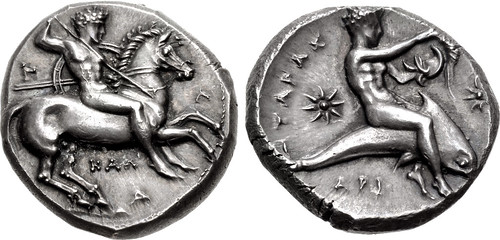
Lot 314–Tarentum Nomos Pedigreed to the Desneux and Colgate Collections & also Pedigreed to the 1905 Carosino Hoard
CALABRIA, Tarentum. Circa 333-331/0 BC. AR Nomos (20mm, 7.81 g, 3h). Nude warrior, shield on left arm, holding two spears in left hand, preparing to cast a third held aloft in his right hand, on horse rearing right; |- to left, ? to right; below, KA? above A / Phalanthos, nude, holding crested helmet with both hands, astride dolphin right; TAPAS to left, stars flanking, API below. Fischer-Bossert Group 60, 770h (V303/R598) = Locker Lampson 13 = Q. Quagliati, “Quattro tesoretti di monete greche rinvenuti a Carosino, Monacizzo, Motola, Francavilla Fontana” in AttiMemIIN VI (1930), p. 27, 28 (this coin); Vlasto 543; HN Italy 896; SNG ANS 967; Gulbenkian 32; Jameson 138; McClean 592 (all from the same dies). Choice EF, wonderful dark cabinet tone. Estimated at $5,000
From the collection of the MoneyMuseum, Zurich. Ex Leu 81 (16 May 2001), lot 9; Jules Desneux Collection (Hess-Leu 49, 27 April 1971), lot 14; Arthur Colgate Collection (Ars Classica XVI, 3 July 1933), lot 73; 1905 Carosino Hoard (IGCH 1928).
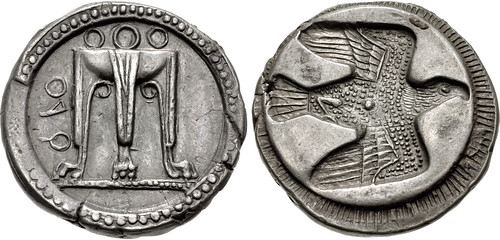
Lot 332–Kroton Nomos Pedigreed to the “Exceptional Private Collection” from Leu 76, 27 October 1999, lot 19
BRUTTIUM, Kroton. Circa 480-430 BC. AR Nomos (22.5mm, 8.03 g, 10h). Dumpy incuse type. Tripod, legs terminating in lion's feet; retrograde (koppa)PO to left / Incuse eagle flying right. Gorini 27 var. (legend on right); Attianese 55 var. (ethnic not retrograde); HN Italy 2108; SNG ANS 288 (same dies): SNG Lloyd 599; Basel –; Dewing –; Gulbenkian –. EF, attractive even dark gray toning, minor flan flaw on obverse. Fine style, well centered and struck. Estimated at $5,000
From the collection of the MoneyMuseum, Zurich. Ex Leu 76 [“Exceptional Private Collection”] (27 October 1999), lot 19.
Roman Imperial Coinage
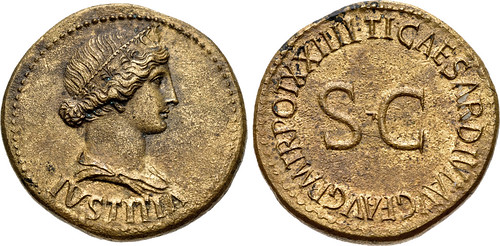
Lot 1008–An Exceptional Tiberius As with IVSTITIA
Tiberius. AD 14-37. Æ Dupondius (29mm, 14.75 g, 12h). Rome mint. Struck AD 22-23. IVSTITIA below, draped bust of Justitia right, wearing stephane ornamented with floral ornaments; her hair fastened in a knot at the back / TI • CAESAR DIVI AVG F AVG P M TR POT XXIIII • large S • C. RIC I 46 (Tiberius); BMCRE 79-80 (Tiberius); BN 57-61 (Tiberius); AdG p. 39 (this coin). EF, lovely Tiber patina, minor surface roughness, traces of deposits. Fine style portrait. Estimated at $10,000
From the collection of the MoneyMuseum, Zurich. Ex Numismatica Ars Classica 15 (18 May 1999), lot 279.

Lot 1048–A Superb Vespasian Aureus
Vespasian. AD 69-79. AV Aureus (19mm, 7.35 g, 6h). Rome mint. Struck AD 77-78. IMP CAESAR VESPASIANVS AVG, laureate head right / COS VIII in exergue, Vespasian standing left, holding spear in right hand and parazonium in left, crowned by Victory standing left, holding wreath in right hand and palm frond in left. RIC II 935; Calicó 624-624a; BMCRE 204; BN 181-2; Biaggi 317; AdG p. 35 (this coin). Superb EF, attractively toned. Estimated at $20,000
From the collection of the MoneyMuseum, Zurich. Ex Leu 72 (12 May 1998), lot 423. Byzantine Coinage

Justinian II. Second reign, 705-711. AV Solidus (20mm, 4.44 g, 6h). Constantinople mint. Struck circa 705. ? N I?S C?S R?X R?GNANTI?M, facing bust of Christ Pantokrator / ? N IVS–tINIA–NVS M?LT?S AN, crowned facing bust of Justinian, wearing loros, holding cross potent set on three steps in right hand, globus cruciger inscribed PAX in left. DOC 1; MIB 1; SB 1413; Kampmann 21 (this coin). Superb EF, lustrous, a few deposits on obverse. Well struck. Estimated at $3,000
From the Collection of the MoneyMuseum, Zurich. Ex Münzen und Medaillen AG FPL 603 (Christmas 1998), no. 143; Leu 50 (25 April 1990), lot 407.
Lot viewing for Triton XVIII will begin on Sunday, January 4th, from 1PM until 7PM in the Carnegie Suite, located on the 18th floor of The Waldorf-Astoria Hotel. The complete lot-viewing schedule for Triton XVIII is:
Sunday, January 4, 2015 – 1PM until 7PM;
Monday, January 5, 2015 – 9AM until 7PM;
Tuesday, January 6, 2015 – 8AM until 6PM; and
Wednesday, January 7, 2015 – 8AM until Noon.
Auction lots will also be available for viewing at the Pennsylvania offices of CNG from Monday, December 1st, 2014 until Wednesday, December 31st, 2014 by appointment only, with the exception of Friday and Saturday, December 12-13, 2014, when the lots will be on exhibit at the San Francisco Historical Bourse (SFHB). The SFHB is held at the Holiday Inn Golden Gateway, Van Ness and California Streets, San Francisco, CA from 10AM until 6PM each day. Please note that CNG’s office hours will be limited during the holiday season.
The auction sessions for Triton XVIII will be held in the Norse Suite, also located on the 18th floor of The Waldorf-Astoria Hotel. Triton XVIII will be conducted over four sessions with the morning sessions beginning promptly at 9:00 AM on Tuesday, January 6th, and Wednesday, January 7th, 2015, and the afternoon sessions will start at 2 PM on the same days.
In addition, there will be an online, Internet-only, Session 5 for Triton XVIII, which CNG will be conducting as our Electronic Auction 342, and will run online concurrently. E-Sale 342 will feature over 1,000 lots, including further selections from the Sunflower Foundation/MoneyMuseum Collection, and will close on Wednesday, January 14, 2015.
Printed catalogs for Triton XVIII will be available after December 1, 2014. To order a catalog, please visit www.cngcoins.com. Catalogs are $50 to North American addresses, and $75 to the rest of the world. Payment may be made by U.S. $ check or Visa/MasterCard. Catalogues will be mailed to customers on CNG’s active mailing list.
CNG is currently accepting consignments for its next mail bid auction, CNG 99, scheduled for May 13, 2015. The consignment deadline is Friday, January 16, 2015. For further details and any additional information, please contact CNG, Inc. at:
Classical Numismatic Group, Inc.
P.O. Box 479
Lancaster, PA 17608-0479
Telephone: (717) 390-9194
Fax: (717) 390-9978
Email: cng@cngcoins.com

EURO BANKNOTES ARRIVE IN LITHUANIA UNDER HIGH SECURITY
 The entire amount of euro bank notes for Lithuania — 132 million banknotes weighing 114 tonnes — have
been safely delivered to the Bank of Lithuania’s vaults.
The entire amount of euro bank notes for Lithuania — 132 million banknotes weighing 114 tonnes — have
been safely delivered to the Bank of Lithuania’s vaults.
Lithuania becomes the 19th eurozone member on Jan. 1, 2015.
“Historically this is the largest shipment of cash to Lithuania. The operation was completed safely and successfully. The euro banknotes are already being distributed from the Bank of Lithuania’s vaults in Vilnius and Kaunas to commercial banks, from where they will continue their journey to trade and service enterprises and, finally, early next year they will reach the pockets of the country’s population. We appreciate the particularly successful cooperation with the partners who participated in the operation,” says Vitas Vasiliauskas, Chairman of the Board of the Bank of Lithuania.
The banknotes reached Lithuania from Germany in three airline flight. Two shipments were delivered to the Bank of Lithuania’s vaults in Vilnius, one — in Kaunas. In escorting the banknotes to the vaults, the Police department, Lithuanian Police Anti-terrorist Operations Unit Aras, traffic police, territorial police, and airport security all participated; helicopters were borrowed from the State Border Guard Service for the operation.
“The police began to prepare for the euro shipment from the moment it became clear that Lithuania would adopt the euro. We worked intensively together with the Bank of Lithuania. This operation will go down in history, and it is an especially important moment for the economy. At the same time it was also a great challenge for the police, and it was able to deal successfully with this challenge,” says Saulius Skvernelis, the Lithuanian Minister of Internal Affairs.
The operation was carried out in accordance with particularly strict security requirements. The public was informed of the banknote delivery ahead of time.
“Such operations are very carefully planned. Our officers participated not only as security for the column transporting the banknotes. We also used snipers, who acted as security from the buildings and helicopters. An additional group of mobile officers was also prepared to react in case of an incident,” told Viktoras Grabauskas, Chief of the Lithuanian Police Anti-terrorist Operations Unit Aras, revealing some details from the operation.
From 1 November the banknotes will be distributed to banks, while from 1 December they will be delivered to retailers and service providers.
In parallel, the Bank of Lithuania continues its acquisition of Lithuanian euro coins. The Lithuanian Mint is minting them in three shifts. The coins are already being delivered from the Bank of Lithuania’s vaults to banks as of early October. In total, the Lithuanian Mint will mint 370 million euro coins, their weight — 1,740 tonnes.
To read the complete article, see:
Euro bank notes reach Lithuania under high security measures
(www.baltictimes.com/news/articles/35821/#.VH-hkDEVhYE)
NEW ZEALAND'S NEW BANKNOTE DESIGNS
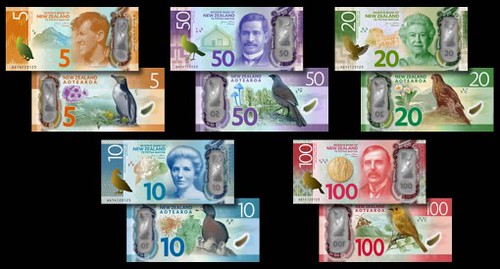
Currency in New Zealand is about to get a major upgrade as part of a "Brighter Money" initiative undertaken by the Reserve Bank of New Zealand.
Under the initiative, $5s, $10s, $20s, $50s and $100s will be pulled from circulation over the next two years and replaced with more secure and vibrant versions. The impetus for the change is to help thwart counterfeiting by using new technological advances.
The new banknotes will still showcase the same denominations, sizes, themes and New Zealanders to include Sir Edmund Hillary, Kate Sheppard, Queen Elizabeth II, Sir Apirana Ngata and Lord Rutherford. They will also still be produced from flexible plastic. What will change is that each note will feature a brighter, more modern look and have marked increases in color contrast from other notes. Denominations will also appear in larger print.
Current plans call for the $5 and $10 banknotes to be released in October 2015 followed by the remaining denominations in April 2016. The older notes will remain legal tender with the Reserve Bank.
The last revisions to New Zealand banknotes occurred 15 years ago.
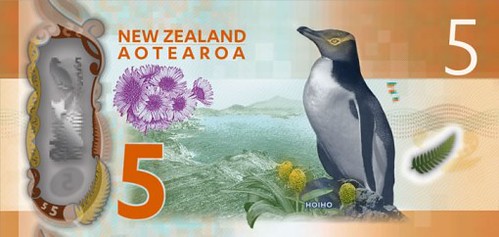
To read the complete article, see:
New Zealand’s Newly Designed Money for 2015 and
2016 (www.coinnews.net/2014/12/05/new-zealands-newly-designed-money-for-2015-and-2016/)

FEATURED WEB SITE: MONEYMUSEUM
This week's Featured Web site is the MoneyMuseum.The MoneyMuseum as a museum for currency and money revolves around power and changes. For every story about money is tightly related to the history of a people or nation, its powers, developments, climaxes and crises. The MoneyMuseum at Hadlaubstrasse investigates this relation in its exhibitions and the multi-media facilities. In doing so, it places its emphasis above all on the Western history of currency, but also provides an insight into the development of money in other regions of the world. And it also considers not only past but also present and future tendencies on the currency and financial markets.
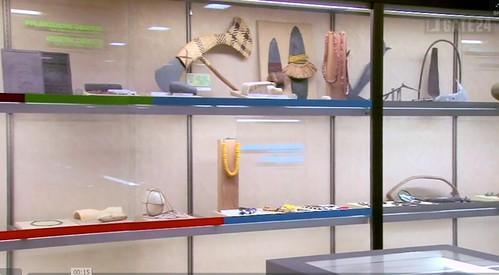
http://sunflower.ch/en/moneymuseum/museum
